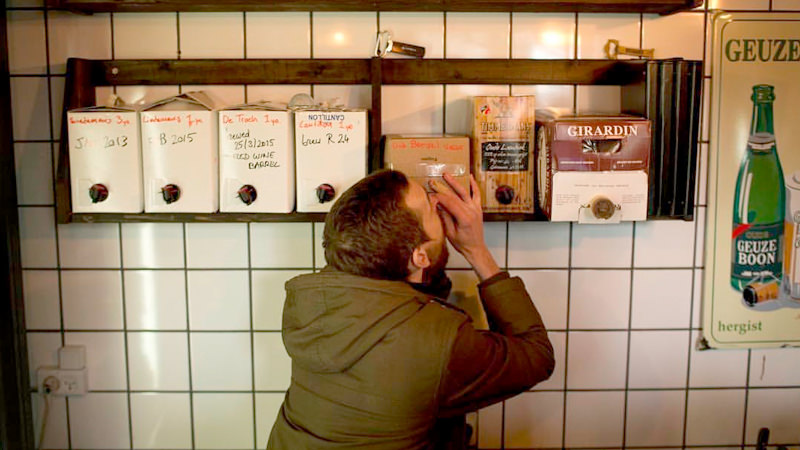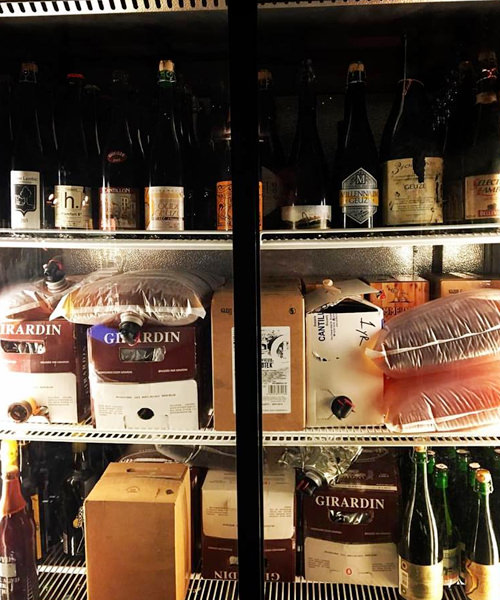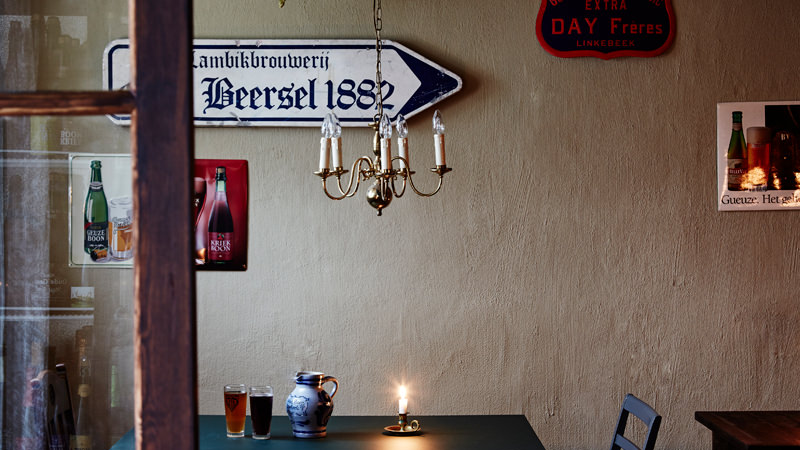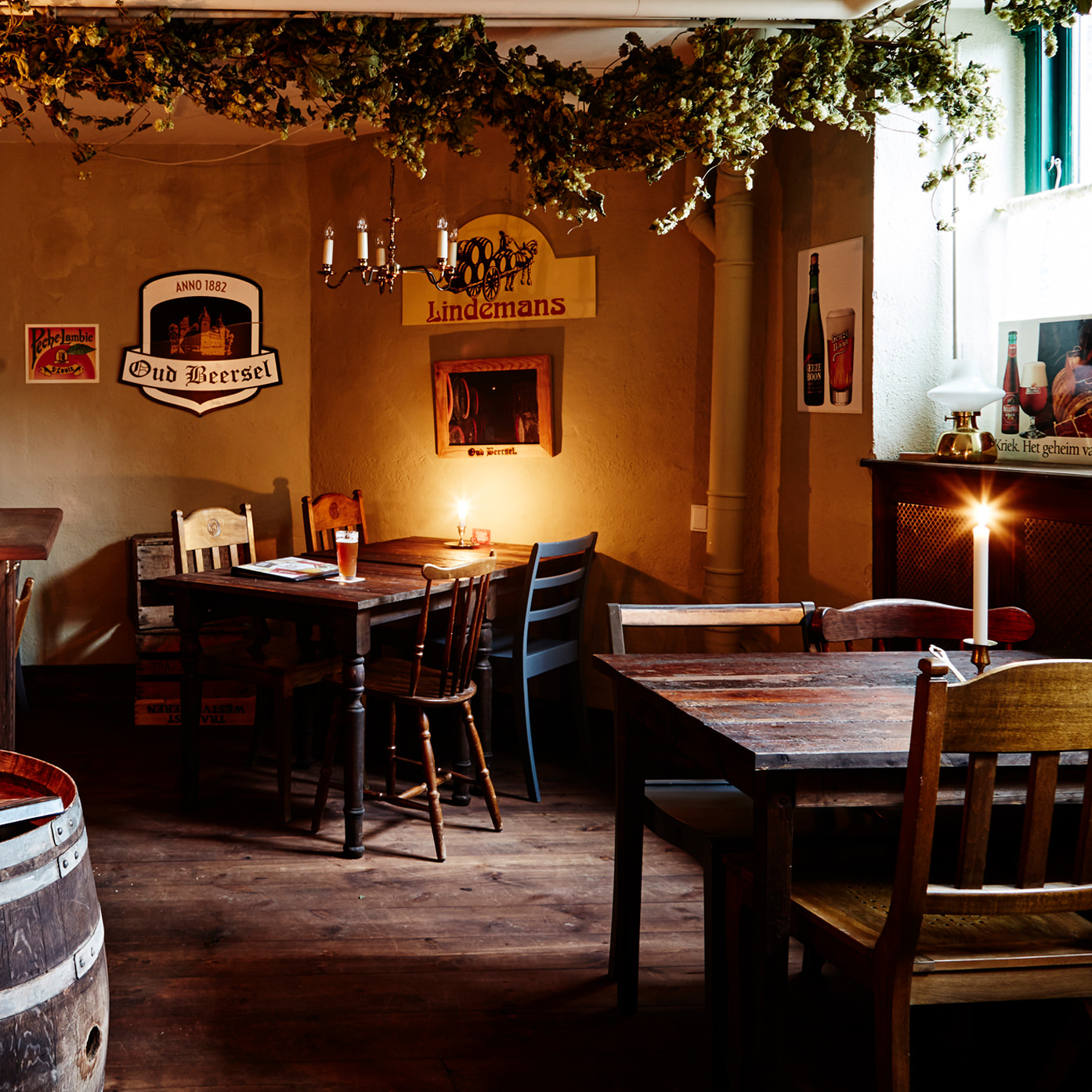Copenhagen’s Koelschip is maybe the best beer bar in the world. An ode to Belgian beers run by Danish craft brewery Mikkeller, it’s the rare supergroup that exceeds expectations.
On a recent visit to Copenhagen, I stopped in. I was in awe of this tiny space with the most spectacular selection of lambics I’ve ever encountered. Decades-old Cantillons, limited release Drie Fonteinens, and rare bottles of Bokkereyder, the most ballyhooed producer of the moment. I was in heaven.
Still, what gave me pause was something I saw behind the counter. One of the glass-encased beer fridges was filled with boxes of lambics. Arguably the world’s most vaunted style of beer, poured from a cheap plastic spigot. Order a 40-krone Timmermans or Girardin at Koelschip, and bartender Dennis Vansant would fill your glass from a cardboard box.

In America, boxes with crummy party wine arose in the mid-1960s. By the 1980s they were everywhere. A cardboard box surrounds a polyethylene bladder filled with three liters of “chillable red” or “sunset blush” wine, all yours for $9.99. Today they are popular props for hard-drinking college kids who utilize bladdered boxes in games like Tour de Franzia and Slap the Bag.
In Belgium, however, bag-in-box lambic is completely normal. Vansant, a Belgian, didn’t understand why I was so blown away by something so commonplace to him.
“Bag-in-box beer was never super prominent due to carbonation, but lambic lends itself well to being bagged, I suppose,” Adam Harbaugh, co-founder of the invaluable Lambic.info, says.
Brewed exclusively in Brussels and the area stretching southwest into Belgium’s Pajottenland region, lambics are fermented spontaneously in coolships and then oak barrels, courtesy of the wild yeasts and bacteria inherent in the air. This makes for exceedingly complex, dry, and acidic beers.
Forget standing in line for cans of New England-style IPAs. It’s lambic and especially gueuze, a three-year lambic blend, that drive beer geeks truly bananas. There are only about a dozen lambic makers left in Belgium, and most of their top bottlings never even make it to the States.
“I think [bag-in-box] is really just an extension of how lambic used to be served,” Harbaugh continues. “At its heart, lambic is a local drink, and a lot of breweries had their regular locals. In those times, it was common to see lambic being served from plastic jugs.” Older bars and cafes still source their lambic this way, Harbaugh says, filling up their boxes at a local brewer and selling the beer by the glass on site.
At bars like Koelschip these bags-in-boxes, also known as cubitainers, contain lambic that’s come straight from the barrel. The unblended, unsweetened, and unpasteurized beer is packaged completely flat. In Belgium it is usually only found on draft, where it often makes for a low-priced pour at Pajottenland’s lambic cafes.
“Girardin started with the 10-liter bag-in-box more than 10 years ago,” Yves Paneels of The Gueuze Society, which organizes lambic-focused events in Belgium, says. “I guess it was about eight or nine years ago when Oud Beersel followed its example with the five-liter bag-in-box.” In recent years, Timmermans, Boon, and Lindemans have followed, but even “sexier” lambic producers like Tilquin, Drie Fonteinen, and Cantillon will fill boxes for special events.
Kurt Verbiest runs the aptly named Belgian in a Box website, one of the few places non-Belgians can score boxes of lambic. He visits the country’s lambic makers weekly to procure cubitainers. Outside of the more common ones, he even sold boxes of a rare, hand-labeled Cantillon “young” lambic back in 2012, though the few people who tried it claimed it tasted of sulphur (“I don’t trust juice-box cantillon. Bottles, baby, bottles, (sic),” wrote a Beer Advocate poster.)
As lambic is mostly sold in five- and 10-liter cubitainers, no matter how much of an acid head you might be, that’s a lot of sour beer to drink yourself. So, if you’re thinking of ordering a box — and shipping ain’t gonna be cheap — how long is it good for?
Since they are vacuum-sealed in the bag, they seemingly can hold indefinitely if unopened — perfect for the lambic-loving doomsday prepper. Even opened, the beer stays in a dark environment with minimal oxidation. Oud Beersel claims its cubitainer is good for up to six months when kept under “ideal” storage conditions (between 39.2 and 50 degrees).
“Gert, the brew-master from Oud Beersel has some Lambiek bag-in-box in his fridge of more than two years old!” Verbiest writes on his website.

Amos Browne, a British homebrewer now living in Chicago, uses cubinators to aid in making his own Bière de Coupage, an obscure blend of old lambic and young beer. Other online homebrewers, like the guys at Ales of Riverwards, have likewise blended their own gueuze to much success. It’s said that’s how Raf Souvereyns of the aforementioned Bokkereyder got his start: blending bags of commercial lambic into his own gueuze, earning him a reputation as a master of the craft and enabling him to eventually “go pro.”
“The sale of the oude lambiek bag-in-boxes has significantly grown over the last couple of years as more people like to blend the lambics themselves and see the results of the blending and the adding of local fruits,” Verbiest notes. “Personally I would like to see a bigger range of lambics from the brewers in the Zenne Valley just so that people would have a bigger choice, but there’s little appetite from the brewers to sell their ‘commodity.’ They’d rather keep the lambic to work with it themselves.”
Of course, those on the nerdiest of nerdy beer forums have known about these cubinators for years. (In fact, if you’re one of them, you can’t even believe how passé this article is). Still, even all-knowing beer geeks recognize how cool these boxes are. Back in 2013, when a Talk Beer forum poster asked whether he should get a box of Girardin lambic, another poster simply responded:
“Yes. Just because it’s baller to have a lambic bag-in-box.”
He’s not wrong. I ordered an Oud Beersel — 60 € in shipping to Brooklyn! — and I did indeed feel like a total baller every time I opened the fridge to get some milk for my daughter, or a Greek yogurt for my wife. If you’ve never had a flat lambic before, it’s a weird sensation. Intensely sour, fruity with slight oak notes, it’s oddly refreshing. You can crush it and, thus, you’ll want a glass every time you open the fridge.
I can see it now: beer geeks trading each other for 10-liter boxes of lambic! People tailgating with cubitainers of Tilquin! Frat houses playing “slap the bag” with Girardin!
(O.K. A boy can dream.)

Bag-in-a-Box Lambic
A few of the more regularly available boxed lambics.
Brouwerij Girardin
Boxed styles: Girardin Oude Lambiek, Girardin Kriekenlambik, Girardin Faro 1882
Sizes: 10L
This small, family-run lambic maker is set on a farm in the village of Sint-Ulriks-Kapelle, a half-dozen miles northwest of Brussels. For the most part, you can only get these boxes from the brewery, which doesn’t offer any sort of tours or tasting. (According to blogger Dave Janssen of Hors Catégorie Brewing, “you meet them in their courtyard parking lot to tell them what you’d like and then you go into the office to pay.”) You will have three choices, each packaged in the same box, a check mark simply noting what is inside, most notably their Girardin Oude Lambiek. This is the base beer for Girardin blends; add cherries and it’s the Kriek, add candied sugar and it’s the Faro.
Brouwerij Timmerman
Boxed styles: Timmermans Oude Lambiek
Sizes: 5L
A brewery and blender in Itterbeek, to the west of Brussels, Timmermans’ logo proclaims it is “The World’s Oldest Lambic Brewery.” Lambic brewing has occurred there since 1692. By the 1960s it was one of the largest brewers around, supplying lambic to other area blenders who used it to make their own gueuze (a common practice). In America it is more famed for sweetened lambics, but aficionados know how good its “oude” products are. Take Oude Lambiek, rarely available to the public, excepting occasional cubitainer releases of the 100 percent oak-aged product.
Brouwerij Oud Beersel
Boxed styles: Oude Lambiek
Sizes: 5L, 10L
This Flemish Brabant blender has been making lambic in Beersel since 1882. For a long time it was known for brewing its own lactic, “green”-tasting lambic. Today, Oud Beersel uses wort from the nearby Brouwerij Boon in its blends. Meant to match an historical recipe, Oud Beersel Oude Lambiek is the base for many of Oud Beersel’s blends and can only be tasted on draft or bag-in-a-box.
Brouwerij Lindemans
Boxed styles: Lindemans Jeune Lambic, Lindemans Vieux Lambic
Sizes: 10L
Better known in America for its artificially sweetened lambic “pops,” Lindemans actually makes a few terrific gueuzes under the Cuvée René billing. Unlike a lot of other top producers that use barrels, this family-owned brewer and blender ages much of its product in stainless steel tanks with wood shavings. The Jeune (young) and Vieux (old) Lambic are the principal components of Cuvée René and typically only found on draft and occasional cubitainer releases.
